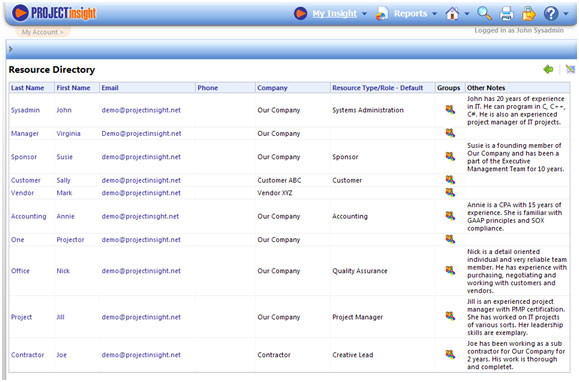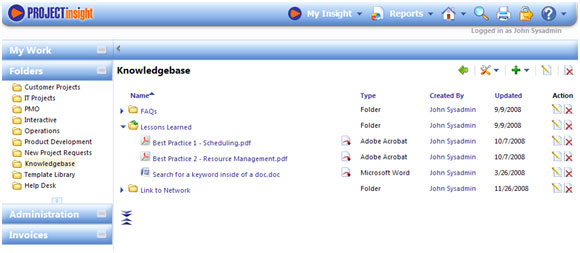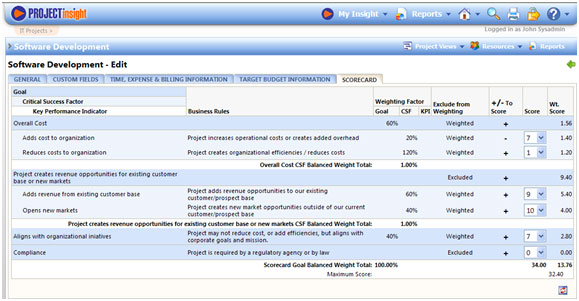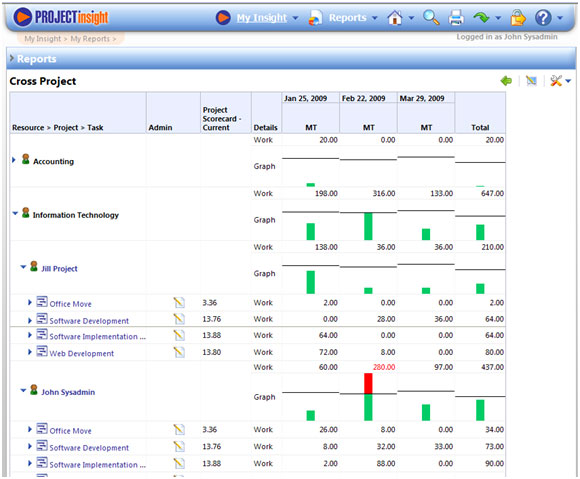Portfolio and Resource Management in an Economic Downturn
By Cynthia K. West, Ph.D., V.P., Project Insight
For the past six months or more, the economic downturn has been a popular news topic. It seems that the news is most often about people that have been laid off. For example, in December, the number of unemployed persons in the United States increased by 632,000 to 11.1 million and the unemployment rate rose to 7.2 percent. (U.S. Department of Labor, Bureau of Labor Statistics).
While job loss is certainly an important topic, a tangential issue that is often overlooked is: 'What is the impact of these layoffs on the people that have been left behind in an organization?' Often times the expectation is that the individuals remaining will pick up the existing workload of those laid off.
How can these resources handle the existing workload? Perhaps that is not the right question, but rather, which projects fit the strategic objectives of the organization? What tools can be used to evaluate the priority of the projects in the portfolio? What solutions exist to help assess the existing projects and tasks? Let's consider some of the common issues and potential solutions to the loss of jobs in an organization.
Challenges Arising from Layoffs
There are several issues that organizations, resource managers and project managers must contend with when job losses occur. These include: replacing resources on existing projects; the loss of best practices, business process and other knowledge; and assessing project priorities.
The most immediate challenge that arises is the replacement of resources on existing projects. More often than not, projects in process still need to be completed on schedule and within budget. The questions that must be answered are: 'Are there resources on the team that have the skill sets to complete the work? Can we transition these tasks without getting behind schedule? Does the organization have an effective way to look into the resource pool and know what skill sets the team members have?
A complementary issue to the loss of resources is the loss of individual, expert knowledge. For example, many times an employee or resource may have been the resident expert in a process. Once laid off, the organization no longer has access to this information. If individual knowledge such as best practices and process knowledge were not documented and stored in a shared location, then the organization loses time as the new resource learns what the process is or worst case scenario, invents a new process.
A higher level challenge is that the workload has just increased, sometimes exponentially, for the remaining resources. How does the organization handle this workload? Does the organization have an efficient way to evaluate and re-assess the projects in the portfolio and their priority levels? Has the organization decided on a method to weigh projects according to their ability to match the strategic objectives of the company?
Solutions
First, how can an organization know which resources in the organization possess the right skills to finish the tasks on projects in progress? There is often no choice but to complete existing projects, particularly if they are client deliverables.
The first step is to create a resource pool in a centralized database. Then, interview the team members and their managers to assess their skill sets and the level of such skills. Store this information in the resources' profiles. For example, Project Insight, web-based project management software, allows resource managers and project managers to store resource information in a 'user profile.' Once stored in this central repository, resource managers or project managers may search the system by skill set or resource type to find the resources they need and assign them to the project and tasks.

Screen shot of resource pool with skill sets
One Project Insight customer has over 550 resources and was recently forced to lay off 10% of its staff. As a result of these layoffs, the resource staffing department had to rapidly reassess their customer projects, tasks and make re-assignments. These changes were made without a hiccup to their client deliverables. The resource managers simply went into the resource pool, viewed the remaining resources and their skill sets and swapped the resources.
In terms of capturing knowledge management and best practices, proactive organizations are documenting their business processes and best practices. These are then stored in a 'knowledgebase' or other shared environment for others to benefit from. Project Insight offers a centralized knowledgebase for project teams to post, store and share best practices documents, lessons learned and business process documents. These may be organized project by project, or in a system level knowledgebase.

Screenshot of knowledgebase
A toy manufacturer that utilizes Project Insight for knowledge management and document sharing finds the centralized storing of assets imperative. As an organization with toy design and development in the United States and manufacturing in Asia, communication due to time zone differences was challenging. Now, by posting all process documents and project assets in Project Insight, the Asian team can read and review documents while the stateside team is asleep. No more staying up late for conference calls.
Most importantly, once the existing projects have been re-assigned and business processes stored, then the organization must turn to the difficult work of determining what projects to move forward with, which projects to delay, or even to cancel. If the team has not done the difficult work of deciding how to measure project priority, then now is the time to do it. The team needs to determine what its organizational goals are, what key performance indicators (KPIs) they are going to use to measure the success of these goals, and develop some criteria that will allow the team to score the projects objectively.
Project Insight allows management teams a scorecard in which they may input their own strategic objectives, goals, critical success factors and KPIs. Once the scoring criteria have been decided upon, each project may be scored by answering the questions. For example, one goal in this economic environment might be to manage costs better. So, one question the team might answer to assess a project's priority is: 'Does this project help the organization reduce cost?'

Screen shot of scorecard
In this case, the score given to the 'software development project' in terms of its reduction of cost to the organization was a one out of ten. However, that is only one criterion. In this scorecard, there are three overall goals. Therefore, the team would score the project on all criteria, then run a report to view all projects and their scores before prioritizing and scheduling the projects.
The example below provides the team insight into the department's workload, the resources that belong to the department and their individual project assignments, any overloaded resources, in addition to the project score. We can see that the project with the highest priority is the software implementation project, which is a customer facing project. Next in line is the web development project. Last in priority is the potential office move project with a score of only 3.36.
 Resource Allocation Report" align="center" style="margin-left:50px;" />
Resource Allocation Report" align="center" style="margin-left:50px;" />
Screen shot of a cross project resource allocation report with project scores
Conclusion
Organizations that have already thought through their strategic objectives, project priorities, and have developed systems for documenting best practices, business processes and ways to share knowledge are in better shape to withstand an economic downturn. Organizations that have insight into their resources' workloads and can know in advance what types of resources they are going to need or perhaps not require, will be more efficient and better poised to survive an economic downturn. Now is the time, more than ever, to put processes in place that will manage the loss of jobs and resources. What's more, developing efficient and effective processes now will also help a team to handle an increased workload when the economy improves.
Back to Project Management Software White Papers.